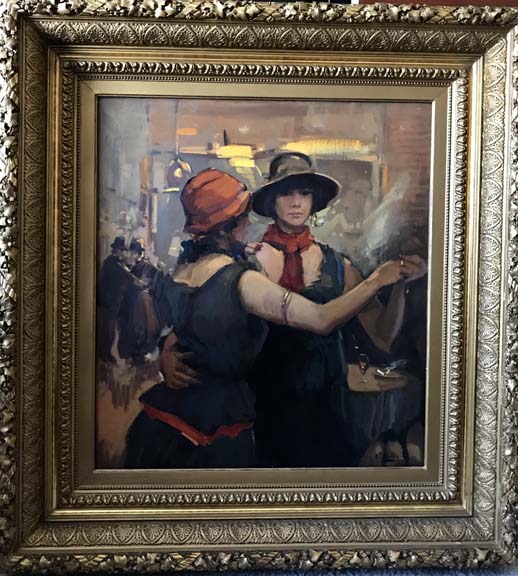

JULIENNE PAULINE ISIDORINE WALTER
"DAN LE CAFE"
OIL ON CANVAS, SIGNED, TITLED
ORIGINAL FRAME
BELGIAN, C.1925
30 X 27 INCHES

Julienne Pauline Isidorine Walter Known as Zoun 1902-1974 Born 9 April 1902, in Ixelles (Brussels); died 21 June 1974, in Paris. Painter, pastellist. Figure compositions, genre scenes, landscapes, still-lifes. Julienne Pauline Isidorine Walter, known as Zoum Walter, was the daughter of Jean vanden Eeckhoudt, the granddaughter of Isidore and the great granddaughter of François Verheyden; she acquired French nationality through her marriage in 1928. She began to paint when she was very young, and was guided by her father at the beginning of her career, but little remains of her first efforts up to 1922. From then until 1928, she painted landscapes, almost all in Roquebrune and the south of France but also some of Brussels, sometimes with figures and still-lifes, for which the title 'Lyrical and Naive Post-Cubism' has been suggested. During this period, she increasingly used pastel to impart spontaneous emotion, retaining oil paint as the medium for reflective and more finished work. From 1929 to 1938, now married and living in Paris, it seems that Walter wished to round off her quasi self-taught training, painting nude studies in the style of Ingres and genre scenes. About 1937 the influence of her father's painting can briefly be detected in her work. From 1945, connecting again with her few previous pictures with figures, she painted a series of religious compositions: Figure Praying, The Shepherds, The Visitation, and The Garden of Gethsemane. From 1952 to 1957, she neglected large-scale compositions. She painted a portrait of her daughter Sylvie among various small format oil paintings, and a great many pastel landscapes: seascapes of the Belt, Parisian gardens, the small valleys of the Oise and Venice, all particularly sensitive to distant horizons and vast skies. Then, following the death of her daughter, she stopped painting until 1963. When she took up painting again, Walter turned to abstraction; in an entirely rigorous way to begin with, but then, until 1969, with an indifference to current trends and a desire to avoid the formulaic, alternating figuration and abstraction. Her abstraction sometimes reveals reminiscences of things seen - urban architecture in particular - and from 1965 was full of symbols ( Fortress of 1966), or stood on the border between the visible world and the world of the imagination. Perhaps fortified by this passage through pure form, she returned after 1969 to the landscape of the garden at Crouy, the Alpilles of Provence, the forests of the Vosges or the Marais of Poitou. In 1972 and 1973, she returned again to what emerged with time as one of the constants of her work - skies, from those of Brabant in 1946 and the Île-de-France from 1947 to 1950, to the pastels of 1965-1966. The landscapes are stripped once again of all detail, merging into the ever more distant and lower horizon line and, with the sky and the infinite, allowing all the space to be invaded like the immensity of a cosmic meditation. At various times, Walter took part in artistic Salons or group exhibitions in Belgium and France. Between 1923 and 1973 she showed several series of her paintings and pastels in group and solo exhibitions, especially in Brussels and Paris, in towns and cities across Belgium and France, in Amsterdam, Oslo, and elsewhere. In 1991 and 1992 there were exhibitions of her paintings and pastels in Paris, and in 1992 the Musée Ingres in Montauban showed a retrospective exhibition of her work as a whole.
Museum and Gallery Holdings: Banja Luka: Small Seascape (undated) Épinal (Mus. départemental d'Art ancien et contemporain): Le Villard (1929, pastel); Modulation (c. 1965); Babel (1967) Ixelles: Gorbio's Elm (1932) La Rochelle (MBA): Light-coloured Oystercatchers (1969); Large White Cloud (1970); Spring in Bloom (1971); Three Brothers (1972) Paris (MAMVP): Houlgate (1956) Paris (MNAM-CCI): Fortress (1966) Uzès: Backstreets of St Clair (1925) |